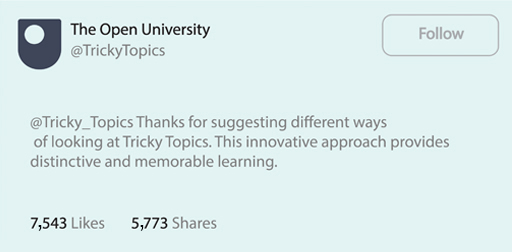2.2 Describing learning experiences
Now complete Activity 1 which further introduces you the word wheel.
Activity 1 Describing learning experiences
Part A Choose 3 words to describe a good learning experience
Think of your own teaching or look back to the needs analysis you conducted in Activity 1 of Week 2. Choose 3 words that you would like students to use to describe the learning experience from one of your lessons or tutor session. If you have no teaching experience perhaps consider how you would describe a good learning experience from your past.
- Select a high level word from the header boxes, or using toggle 1 on the word wheel (e.g. one from: innovative, demanding, professional or supportive).
- Then choose one of the three specific words on the next row that describes the first word more precisely using toggle 2 on the word wheel (e.g. If you selected ‘Innovative’ you can then choose from: different, amazing or interactive).
- Finally select one of the three more granular words that describes the second word more precisely using toggle 3 on the word wheel (e.g. ‘pioneering’).
You should now have selected three words which you would like students to say about your teaching, such as ‘innovative’, ‘different’ and ‘distinctive’.
Part B More practice of the word wheel
Now use the wheel to find three words to describe your learning experience of this course so far. Why not write a tweet to @Tricky_Topics telling us what you think?
Record your three words here and keep these words in mind as you design your tricky topics learning intervention.
Answer
Here’s one example using three words:
Learning management systems such as Moodle and Blackboard have become immensely popular in schools, colleges and universities in recent years as a means to distribute lecture notes and other course information. They are a portal for students to upload assignments and to check them for plagiarism, and as chat forums where students can communicate with their teachers/lecturers and with each other. Both platforms allow for easy integration with social media services so that teachers can push content automatically to Apps like Twitter, Facebook or LinkedIn. With most people now owning a smart phone, and social media usage accounting for approximately 30% of online smart phone activity, using social media to engage with others in a teaching and learning environment is becoming far more popular. How might you engage with social media and continuing professional development?
Part C Engaging with social media
Consider how using social media can be useful in your own context.
Whether you already use Moodle or Blackboard to engage with your students or receive feedback about your teaching, think now about how you can develop your current practice to use more social media. Can you use it to hear the student voice? Can you learn more about tricky topics, either from your students or from other teachers, through incorporating Twitter or other social media into your current practices?
Write a few notes here.
Hearing the student voice is an overarching learning design principle and will inform the design of the activities of your tricky topic intervention. The three words you thought of can be used as a reference point throughout the design and execution of the intervention.
Obviously these three words are not the actual student voice, only the ones you have decided you would like students to say about your teaching. However, they will guide you to develop an intervention which should deliver what you want.
For example:
- Janine is writing materials about computer coding. She would like learners to consider her interventions ‘demanding’ and ‘stimulating’.
- Alex is Head of Learning at the NHS. He would like his learners to consider their learning to be ‘professional’ and ‘practical’.
As a result the materials they both produce will look very different if they apply these principles throughout their design.
You may wish to find out what your students really think about your teaching by asking them for three words after you have delivered your learning intervention.

